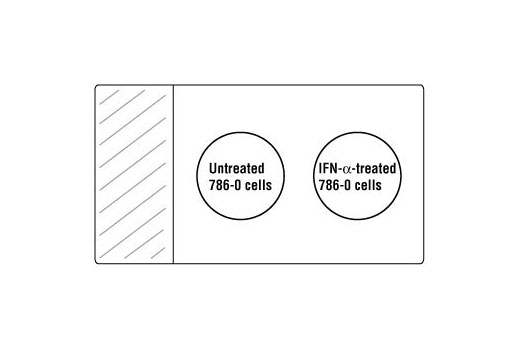| Kit Includes | Quantity | Antigen Retrieval / Diluent | Isotype |
|---|---|---|---|
| Phospho-Stat1 (Tyr701) (58D6) Rabbit mAb #9167 | 40 µl | EDTA / SignalStain® Antibody Diluent #8112 | Rabbit IgG |
| Phospho-Stat3 (Tyr705) (D3A7) XP® Rabbit mAb #9145 | 40 µl | EDTA / SignalStain® Antibody Diluent #8112 | Rabbit IgG |
| Phospho-Stat5 (Tyr694) (C11C5) Rabbit mAb #9359 | 40 µl | EDTA / SignalStain® Antibody Diluent #8112 | Rabbit IgG |
| *SignalStain® Antibody Diluent #8112 | 25 ml | ||
| †SignalSlide® Phospho-Stat1/3/5 IHC Controls #8105 | 1 Pack |
*SignalStain® Antibody Diluent is supplied as a working solution and should be stored at 4ºC (packaged separately).
†Control slides should be stored at 4ºC (packaged separately).
#P40763, #P42229, #P42224
6774, 6776, 6772
Product Information
Storage
Specificity / Sensitivity
Source / Purification
Monoclonal antibody is produced by immunizing animals with a synthetic phosphopeptide corresponding to residues surrounding Tyr701 of human Stat1, Tyr705 of mouse Stat3, or Tyr694 of Stat5a.
Product Description
Background
Stat proteins serve as transcription factors in growth and survival pathways stimulated by growth factor and cytokine activation of receptor proteins. Receptor activation promotes tyrosine phosphorylation of Stat proteins, resulting in Stat dimerization and translocation to the nucleus where they regulate expression of numerous proteins that control cell growth, survival, differentiation and pathogen resistance (1). Stat1 is essential in IFN-α and IFN-γ stimulated pathways and is abnormally activated in many tumors (2,3). Both Stat1α (91 kDa) and Stat1β (84 kDa) isoforms are activated by IFN-α but only Stat1α responds to IFN-γ. Phosphorylation of Stat1 at Tyr701 induces Stat1 dimerization, nuclear translocation and DNA binding (4). Transcription factor Stat3 possesses oncogenic potential and anti-apoptotic activities; a number of human tumors display constitutively activated Stat3 (5,6). Activation of Stat3 follows phosphorylation at Tyr705, resulting in dimerization, nuclear translocation and DNA binding (7). Expression of Stat3α (86 kDa) and Stat3β (79 kDa) isoforms correlates with cell type, ligand and cell maturation stage (8). Phosphorylation of Stat5a at Tyr694 is essential for transcription factor activation (9). Stat5 is activated by interleukins and other cytokines (i.e. CSF1); presence of phosphorylated Stat5 is in some IL-3-treated cells suggests a role in angiogenesis and cell motility (10). Altered Stat5 expression and activity is associated with abnormal cell proliferation and apoptosis in some forms of leukemia (11).
- Ihle, J.N. (2001) Curr Opin Cell Biol 13, 211-7.
- Bromberg, J. (2002) J Clin Invest 109, 1139-42.
- Frank, D.A. (1999) Mol Med 5, 432-56.
- Ihle, J.N. et al. (1994) Trends Biochem Sci 19, 222-7.
- Garcia, R. and Jove, R. (1998) J Biomed Sci 5, 79-85.
- Catlett-Falcone, R. et al. (1999) Immunity 10, 105-15.
- Darnell, J.E. (1997) Science 277, 1630-5.
- Biethahn, S. et al. (1999) Exp Hematol 27, 885-94.
- Gouilleux, F. et al. (1994) EMBO J 13, 4361-9.
- Buitenhuis, M. et al. (2004) Int J Biochem Cell Biol 36, 2120-4.
- Baśkiewicz-Masiuk, M. et al. (2003) Cell Prolif 36, 265-78.
Species Reactivity
Species reactivity is determined by testing in at least one approved application (e.g., western blot).
Cross-Reactivity Key
H: human M: mouse R: rat Hm: hamster Mk: monkey Vir: virus Mi: mink C: chicken Dm: D. melanogaster X: Xenopus Z: zebrafish B: bovine Dg: dog Pg: pig Sc: S. cerevisiae Ce: C. elegans Hr: horse GP: Guinea Pig Rab: rabbit All: all species expected
Trademarks and Patents
Limited Uses
Except as otherwise expressly agreed in a writing signed by a legally authorized representative of CST, the following terms apply to Products provided by CST, its affiliates or its distributors. Any Customer's terms and conditions that are in addition to, or different from, those contained herein, unless separately accepted in writing by a legally authorized representative of CST, are rejected and are of no force or effect.
Products are labeled with For Research Use Only or a similar labeling statement and have not been approved, cleared, or licensed by the FDA or other regulatory foreign or domestic entity, for any purpose. Customer shall not use any Product for any diagnostic or therapeutic purpose, or otherwise in any manner that conflicts with its labeling statement. Products sold or licensed by CST are provided for Customer as the end-user and solely for research and development uses. Any use of Product for diagnostic, prophylactic or therapeutic purposes, or any purchase of Product for resale (alone or as a component) or other commercial purpose, requires a separate license from CST. Customer shall (a) not sell, license, loan, donate or otherwise transfer or make available any Product to any third party, whether alone or in combination with other materials, or use the Products to manufacture any commercial products, (b) not copy, modify, reverse engineer, decompile, disassemble or otherwise attempt to discover the underlying structure or technology of the Products, or use the Products for the purpose of developing any products or services that would compete with CST products or services, (c) not alter or remove from the Products any trademarks, trade names, logos, patent or copyright notices or markings, (d) use the Products solely in accordance with CST Product Terms of Sale and any applicable documentation, and (e) comply with any license, terms of service or similar agreement with respect to any third party products or services used by Customer in connection with the Products.
